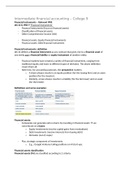College aantekeningen
Lecture notes Intermediate Financial Accounting - Part 2
- Instelling
- Tilburg University (UVT)
Dit document bevat alle lecture notes van colleges 9 tm 12 uit collegejaar 2021/2022. Daarnaast bevat het document enkele voorbeelden die ook als voorbeeld dienen voor de tentamenvragen. De voorbeelden hebben mij geholpen bij het begrijpen en toepassen van de theorie.
[Meer zien]





